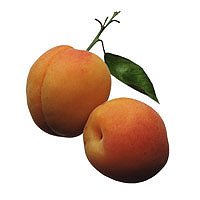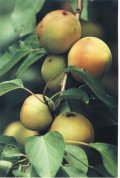Apricot
http://www.100md.com
《e Natural Health Center》
 |
 |
 |
Fruits
Apricot
Latin:
Prunus armeniaca
Origin:
Apricot is the fruit Prunus armeniaca L., or Armeniaca vulgaris (Lam.), of the family Rosaceae, that is cultivated throughout the temperate regions of the world. Native to China, where it has been grown for over 4,000 years, and was purportedly brought to the West by Alexander the Great. The apricot is now cultivated in all of Central and Southeast Asia and in parts of southern Europe and North Africa. It was doubtless among the fruits brought into southern California early in the 18th century by Spanish missionaries. The American Pomological Society lists 11 varieties grown in the United States in 1879. In the United States, most apricots are grown in California, as they do not thrive as well on the East Coast.
, 百拇医药
Apricot trees are large and spreading with broad, ovate leaves that have pointed tips. The tree grows to about 9 m by 6 m at a medium rate. It is in flower from March to April, and the seeds ripen from July to September. The flowers are hermaphrodite (have both male and female organs) and are pollinated by insects. The leaves are bright green in color and are held erect on the twigs. The flowers are white in full bloom and borne singly or doubly at a node on very short stems. It can grow in semi-shade (light woodland) or no shade, and requires moist soil.
, 百拇医药
The apricot sets fruit after self-pollination of its blossoms. The pit, or stone, is large, flat, and smooth. The fruit is nearly smooth, round to oblong in some varieties, somewhat flattened, and in general more like the peach in shape, but with little to no hairiness when ripe. Its flesh is typically a rich yellow to yellowish orange. The kernels of some varieties are sweet, though they are poisonous until roasted.
Apricots are propagated by budding on peach or apricot rootstocks, and the peach, plum, and apricot may be readily intergrafted. The tree succeeds in a well-drained loamy soil, preferably light rather than heavy. Most varieties withstand winter cold as well as peaches, but the blossom buds, opening earlier than those of the peach, are frequently killed by late freezes. Among the more common varieties of apricot are the Derby, Moorpark, Royal, and Tilton. In California, two plum/apricot hybrids are sold under the names "plumcot" and "aprium."
, http://www.100md.com
Apricots are in season from late May through early August, peaking in June and July. Canned and dried apricots are available year-round.
The apricot trees are quite drought-resistant and under favorable growing conditions are long-lived, some living 100 years or longer.
The leading country in apricot production is Spain and Turkey. Other important producers are Iran, Syria, the United States, France, and Italy.
, http://www.100md.com
See also Food, Nuts and Seeds, Almond.
Properties:
Sweet and sour in flavor, warm in nature, it is related to the stomach and the lung channels.
Functions:
Lubricates the lungs, relieves asthma, produces or nourishes fluids, quenches thirst.
Applications:
, 百拇医药
1. Used for excessive thrist and dry mouth due to deficiency of yin in the stomach:
Eat the fruit in raw.
2. Used for dry coughs or asthma due to lung heat:
Eat the fruit in raw.
3. Used for prolonged diarrhea:
Serve the apricot that is cooked with honey.
Dosage and Administration:
, http://www.100md.com
The apricot fruit can be served in raw, or cooked with honey, canned, candied, stewed like peaches or nectarines, or as dry fruit. They can be used in pies, cakes, sorbets, yogurt, crepes, jams, and chutneys. Since apricots do not ship well, they are usually picked too soon, hampering their maturation into full flavor. Using them dried may be preferable in areas out of their growing range. It is best to soak dried fruit in filtered boiling water before serving. Apricot seed kernels can be made into brandies and liquors.
, 百拇医药
Choose plump and juicy apricots that are not too soft. Their deep orange color does not necessarily guarantee ripeness, although those with deeper color are likely to be riper than pale yellow or green ones. The best apricots often have a tempting aroma. Avoid fruit with cracks in the skin, or that shows white spots, which indicate mold. Handle apricots tenderly as they bruise easily, and bruising causes rapid spoiling. Lemon juice prevents the flesh from darkening after slicing. After the central stone is removed, the fruit can be frozen in slices or pureed. Dried apricots can be found at the market more often than fresh ones, and they work well in many recipes.
, 百拇医药
Bitter seeds should be eaten in strict moderation, but sweet ones can be eaten freely. The bitter seeds can be used as a substitute for bitter almonds in making marzipan, etc.
Cautions on Use:
Because apricot is warm in nature, avoid eating it in excess, otherwise, it could damage the teeth and harm the stomach to the extent of feeling unrest. Those who are of the heat type should take caution in eating apricots.
, 百拇医药
Also, this species produces hydrogen cyanide, a poison that gives almonds their characteristic flavor. This toxin is found mainly in the leaves and seed and is readily detected by its bitter taste. Usually present in too small a quantity to do any harm, any very bitter seed or fruit should not be eaten.
In small quantities, hydrogen cyanide has been shown to stimulate respiration and improve digestion, it is also claimed to be of benefit in the treatment of cancer. In excess, however, it can cause respiratory failure and even death.
, 百拇医药
Reference Materials:
Toxic or Side Effects:
The kernels of the apricot are poisonous until roasted.
Modern Researches:
Apricots are a good source of vitamins A, B, C, and are high in natural-sugar content and fiber; also contains protein, calcium, phosphorus and carotene. Dried apricots are an excellent source of iron.
, 百拇医药
Apricot fruits are nutritious, cleansing and mildly laxative. They are a valuable addition to the diet working gently to improve overall health. A dark grey to green dye can be obtained from the fruit.
The flowers are tonic, promoting fertility in women.
A green dye can be obtained from the leaves.
The seed is analgesic (insensibility to pain), anthelmintic (expelling or destroying parasitic worms especially of the intestine), anti-asthmatic, anti-spasmodic, antitussive (cough suppressant), demulcent (soothing), emollient (soothing especially to the skin), expectorant, pectoral (worn on the breast), sedative and vulnerary (used for or useful in healing wounds). It is used in the treatment of asthma, coughs, acute or chronic bronchitis and constipation.
, http://www.100md.com
The seed contains 'laetrile', a substance that has also been called vitamin B17. This has been claimed to have a positive effect in the treatment of cancer, but there does not at present seem to be much evidence to support this. The pure substance is almost harmless, but on hydrolysis it yields hydrocyanic acid, a very rapidly acting poison - it should thus be treated with caution. In small amounts this exceedingly poisonous compound stimulates respiration, improves digestion and gives a sense of well-being.
, 百拇医药
The seed contains up to 50 percent of an edible semi-drying oil. The oil has a softening effect on the skin and so it is used in perfumery and cosmetics, and also in pharmaceuticals.
The bark is astringent. The inner bark and/or the root are used for treating poisoning caused by eating bitter almond and apricot seeds (which contain hydrogen cyanide). A report says that a decoction of the outer bark is used to neutralize the effects of hydrogen cyanide. The decoction is also used to soothe inflamed and irritated skin conditions. An edible gum is obtained from the tree trunk.
The wood of the apricot tree is handsome, hard, durable., 百拇医药